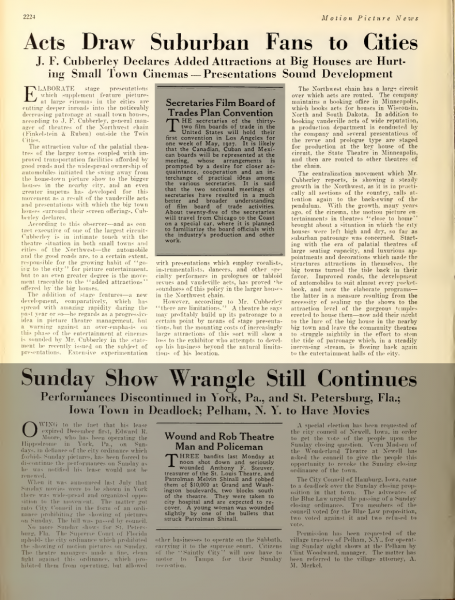| Artifact Type | Sources, Trade Journals |
| Publication | Motion Picture News |
| Volume | XXXIV |
| Number | 24 |
| Page Number | 2224 |
| Place | New York |
| Publication Date | December 11, 1926 |
| Transcript | Show/Hide |
|
Headline: “Acts Draw Suburban Fans to Cities” Subhead: J. F. Cubberley Declares Added Attractions at Big Houses are Hurting Small Town Cinemas — Presentations Sound Development Elaborate presentations which supplement feature pictures at large cinemas in the cities are cutting deeper inroads into the noticeably decreasing patronage at small town houses, according to J. F. Cubberley, general manager of theatres of the Northwest chain (Finkelstein & Ruben) outside the Twin Cities. The attraction value of the palatial theatres of the larger towns coupled with improved transportation facilities afforded by good roads and the widespread ownership of automobiles initiated the swing away from the home-town picture show to the bigger houses in the nearby city, and an even greater impetus has developed for this movement as a result of the vaudeville acts and presentations with which the big town houses surround their screen offerings, Cubberley declares. According to this observer—and as contact executive of one of the largest circuits Cubberley is in intimate touch with the theatre situation in both small towns and cities of the Northwest—the automobile and the good roads are, to a certain extent, responsible for the growing habit of “going to the city” for picture entertainment, but to an even greater degree is the movement traceable to the “added attracts offered by the big houses. The addition of stage features—a new development, comparatively, which has spread with amazing rapidity during the year or so—he regards as a progressive idea in picture theatre management, but a warning against an over-emphasis on this phase of the entertainment at cinemas is sounded by Mr. Cubberley in the statement he recently issued on the subject of presentations. Extensive experimentation with presentations which employ vocalists, instrumentalists, dancers, and other specialty performers in prologues or tabloid revues and vaudeville acts, has proved the soundness of this policy in the larger houses in the Northwest chain. However, according to Mr. Cubberley “there are limitations.” A theatre he may profitably build up its patronage to a certain point by means of stage presentations, but the mounting costs of increasingly large attractions of this sort will show a loss to the exhibitor who attempts to develop his business beyond the natural limitations of his location. The Northwest chain has a large circuit over which acts are routed. The company maintains a booking office in Minneapolis, which books acts for houses in Wisconsin, North and South Dakota. In addition to booking vaudeville acts of wide reputation, a production department is conducted by the company and several presentations of the revue and prologue type are staged for production at the key house of the circuit, the State Theatre in Minneapolis, and then are routed to other theatres of the chain. The centralization movement which Mr. Cubberley reports, is showing a steady growth in the Northwest, as it is in practically all sections of the country, sails attention again to the back-swing of the pendulum. With the growth, many years ago, of the cinema, the motion picture entertaimnents in theatres “close to home” brought about a situation in which the city houses were left high and dry, so far as suburban patronage was concerned. Starting with the era of palatial theatres of large seating capacity, and luxurious appointments and decorations which made the structures attractions in themselves, the big towns turned the tide back in their favor. Improved roads, the development of automobiles to suit almost every pocketbook, and now the elaborate programs—the latter in a measure resulting from the necessity of sealing up the shows to the attraction level of the gorgeous temples erected to house them—now add their might to the lure of the big house in the nearby big town and leave the community theatres to struggle mightily in the effort to stem the tide of patronage which, in a steadily increasing stream, is flowing back again to the entertainment halls of the city. |
|
| Archive | The Internet Archive |
| Read In Context | https://archive.org/stream/motionpicture34moti#page/n515/mode/2up |
| Citation | “Acts Draw Suburban Fans to Cities,” Motion Picture News, December 11, 1926. |
| Tags | 1926December 1927 |
